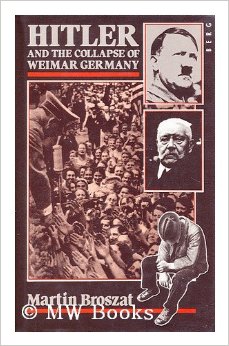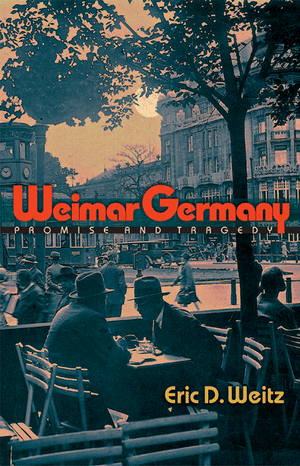Broszat, Martin. Hitler and the Collapse of Weimar Germany. Trans. V. R. Berghahn. Leamington Spa: Berg, 1987.
This is a thin, but important book of political history. In it, Broszat traces the complex political trends of the Weimar era, as well as the intricate deals forged by Germany’s leading politicians and economic elite at the time. Though this is primarily a political history, Broszat does offer some glances into larger socio-cultural developments during the 1920s and 1930s. He hints at what Detlev Peukert takes as the central issue of his own book: the effects of modernization and the rise of mass culture on German politics. Ultimately, Broszat sees this new, mass culture as the key to the Nazis’ success in gaining control of the German government in 1933.
Broszat opens his book with a brief history of the National Socialist German Workers Party (NSDAP or Nazi Party) and shows that it was only one among many right wing, nationalist parties. “What marked [Hitler] out among the speakers of the political Right was the way in which he put his message across” (2). This point epitomizes Broszat’s larger argument that it was not Nazism’s message itself that made it unique or successful, but instead the manner in which the message was expressed and distributed. NSDAP leadership – and Hitler in particular – recognized that the masses could not be ignored in any new political system. Consequently, the Nazis saw the masses as a source of power that should be tapped into through modern technology and political aesthetics. In this light, the National Socialists were a truly modern political party, not the culmination of an older German character. “Nazi ideology was almost totally a product of mass culture and political semi-illiteracy which proliferated since the late nineteenth century” (38).
After demonstrating that National Socialism was a modern creation, Broszat lays out the conditions that allowed for the rise of the Nazi Party. National Socialism emerged in Germany after the First World War during a period of worldwide economic recession and against the background of a general crisis of modernity and civilization” (37). The SPD-led Weimar Coalition enjoyed success only during times of material improvement or stability (53); otherwise, it was attacked from all sides: the Communists on the Left and conservative nationalists like the Nazis on the Right. The election of Paul von Hindenburg as Reich President in 1925 was a “symptom of backward looking tendencies,” Broszat claims (67).
While the election of Hindenburg symbolized a shift to the Right in Weimar mentality, the Republic was not destroyed until Chancellor Brüning was forced to resign in May 1932. The new chancellor led a coup against Prussia, trying to separate its government from the Reich’s, and the SPD did nothing to protest, thus paving the way for an authoritarian, nationalistic government (120, 146). The rest of the book is dedicated to revealing the political maneuvering that led to Papen’s ousting, Schleicher’s short chancellorship, and finally Hitler’s appointment as Reich Chancellor in January 1933.
Throughout the book, Broszat reveals how the NSDAP was able to gather followers. Nazism “seemed to offer a strong determined leadership, a pseudo-democratic mobilization of the masses and their participation in the promised national revival; it looked like a ‘third way’ between democracy and the state authoritarianism of the olden days. Herein lay the lure of Nazism” (94). As the NSDAP gained more success, its more radical messages were toned down, thus appealing to a wider audience among the working class, bourgeoisie, and old elite. The old conservative elites lacked this mass appeal and that is why they compromised and agreed to place the Nazis in power, hoping they could keep Hitler and his party on a short leash.
To see more books on the history of modern Germany, see my full list of book reviews.




